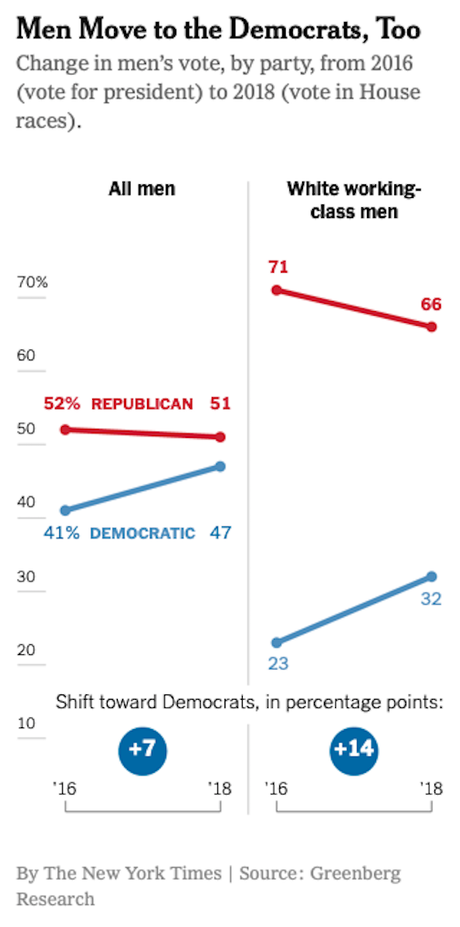

In his New York Times column, Stanley B. Greenberg notes four trends from the recent election. These voting trends gave the Democrats their huge victory, and should be of serious concern for the future -- especially 2020, when they will probably go into the election with Trump at the head of the ticket. Here's what the 2018 election showed:
First of all, Democrats did not win simply because white women with college degrees rebelled against Mr. Trump’s misogyny, sexism and disrespect for women. Nearly every category of women rebelled. . . .
Yes, House Democrats increased their vote margin nationally among white women with at least a four-year degree by 13 points compared with the Clinton-Trump margin in 2016. But Democrats also won 71 percent of millennial women and 54 percent of unmarried white women (who split their votes two years earlier). In 2018, unmarried white women pushed up their vote margin for Democrats by 10 points. In fact, white women without a four-year degree (pollster shorthand for the white working class) raised their vote margin for Democrats by 13 points.
Overall, white women split their vote between Democrats and Republicans, but it is clear which way they are moving. Interestingly, the white college women who were supposed to be the “fuel for this Democratic wave” played a smaller role in the Democrats’ increased 2018 margin than white working class women, because the former were 15 percent of midterm voters and the latter 25 percent. . . .
Second, Mr. Trump and his party maintained their principal base with white working class voters, the shift among women notwithstanding, and Democrats still need to do better. Nonetheless, Democrats got their wave in part because a significant portion of male and female white working class voters abandoned Mr. Trump and his Republican allies.
In 2016, the white working class men that Mr. Trump spoke most forcefully to as the “forgotten Americans” gave him 71 percent of their votes and gave only 23 percent to Hillary Clinton. This year, the Republicans won their votes with a still-impressive margin of 66 to 32 percent. But what was essentially a three-to-one margin was deflated to two-to-one, which affected a lot of races. . . .
Third, Democrats made big gains because Mr. Trump declared war on immigrants — and on multicultural America — and lost. His ugly campaign succeeded in making immigration and the border a voting issue for the Republican base, according to the postelection survey I did with Democracy Corps, which asked those voting Republican why they did. “Open borders” was the top reason given for voting against a Democratic candidate. But it backfired among other voters.
On Election Day, a stunning 54 percent of those who voted said immigrants “strengthen our country.” Mr. Trump’s party lost the national popular vote by seven points, but he lost the debate over whether immigrants are a strength or a burden by 20 points. Mr. Trump got more than half of Republicans to believe immigrants were a burden, but three quarters of Democrats and a large majority of independents concluded that America gains from immigration. . . .
Fourth, Democrats could not have picked up as many House seats as they did in 2018 without raising their share of the vote by four points in the suburbs, which have grown to encompass 50 percent of voters. Mrs. Clinton won many of these districts in 2016, so it was clear that any further shift in the Democrats’ direction would prove consequential. But Democrats made their biggest gains not there, but in the rural parts of the country. That was the shocker. Democrats cut the Republicans’ margin in rural areas by 13 points, according to the Edison exit poll and by seven points in one by Catalist. Democrats still lost rural America by somewhere between 14 and 18 points so that left Democrats in a pickle there. That had implications for the Senate, but it shouldn’t conceal the fact that Democrats actually made progress in rural areas.

